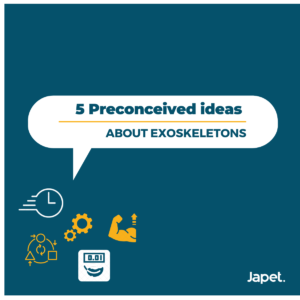5 Preconceived ideas about exoskeletons
There are many preconceived ideas about exoskeletons. To help you better understand what an exoskeleton really is or isn’t, we wanted to share with you the most common ones.

1- “Exoskeletons are the only solution to the MSD problem”.

Before considering the integration of physical assistance devices or robots, it is necessary to first establish a global risk analysis approach including health indicators and human resources management.
This is followed by the implementation of preventive actions, whether they be organisational, human, ergonomic or automation adjustments… no option should be put aside.
It is only after having resorted to this risk analysis approach that a company can envisage the integration of physical assistance solutions such as exoskeletons.

At Japet, our team of product experts supports you in your approach to improving the quality of life at work.
2- “The use of an exoskeleton is suitable for any type of job.”

An exoskeleton is a solution to a targeted problem, it cannot cover the whole body or fit perfectly in every work situation.
The need for physical assistance is specific. It is therefore important to understand and identify the worker in difficulty and/or the workstation at risk.
The specificity of use of an exoskeleton means that it cannot be used for all tasks.
The analysis of the target position must therefore assess the physical workload of the job and of each of the tasks in the job.

At Japet, carry out a free online diagnosis to validate the suitability of the product for the targeted workstation.
3- “Exoskeletons are heavy and require a lot of settings”.

The weight and the number of settings of an exoskeleton can be an obstacle to their use. Manufacturers have understood this and have sought to optimise them by reducing their weight and making them easier to set.
Today, we find exoskeletons that weigh less than 5 kg, are less cumbersome and have few settings.
However, as with any new equipment, there is a period of familiarisation with the settings.
Good to know : the weight of an exoskeleton varies according to the technology chosen when it was designed.

The Japet.W weighs less than 2 Kg.
The Japet advantage : our support ! We train the user and a consultant in the installation and use of the exoskeleton.
4- “Exoskeletons lighten the weight of the load carried and increase strength tenfold.”

The aim of exoskeletons is not to increase human capabilities but to assist in certain tasks and awkward postures: they do not lighten the weight of the load !
Through their mechanical or robotic system, they limit the impact of the load on the part of the body targeted by the exoskeleton (arm, back, neck, etc.)
In companies, they are used as a technical prevention solution to avoid the risk of MSDs appearing or worsening at work when it is impossible to adapt the workstation.

The Japet.W prevents musculoskeletal back disorders and relieves back pain.
5- “The integration of an exoskeleton in a company is immediate.”

The integration of an exoskeleton in a company requires several steps with multiple objectives:
- To accompany the integrators in the decision making process and the implementation of the exoskeleton within the company,
- To ensure that the use is adapted to the employee and the tasks that he/she will perform, via the needs assessment stages.
- Finally, to collect feedback in order to adjust the use if necessary.

At Japet, we support you throughout the integration of Japet.W with a personalised follow-up with your collaborators.
For more answers to any questions you may have about exoskeletons, go to our Frequently Asked Questions !
To find out more, discover all the INRS resources, for information on the interests and limits of exoskeletons on the health and safety of employees.
